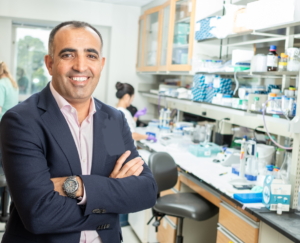
Northwestern Medicine investigators have discovered a potential therapeutic target for the most common type of pancreatic cancer, according to a study published in Developmental Cell.
The findings suggest ISL2, a transcription factor, can act as a tumor suppressor in pancreatic ductal adenocarcinoma (PDA) tumors and that its depletion reprograms PDA cells’ transcriptional and metabolic states.
“ISL2 status could be a precision medicine approach where we can check the tumor, look at ISL2 levels and then determine if these tumors are more dependent on lipid metabolism or if we should inhibit this pathway in these kind of tumors,” said Mazhar Adli, PhD, associate professor of Obstetrics and Gynecology in the Division of Reproductive Science in Medicine and senior author of the study.
PDA has a poor survival rate — more than 80 percent of patients are diagnosed when the cancer is late-stage and the tumor no longer qualifies for surgical removal. Following diagnosis, average patient survival is typically four to six months.
By nature, PDA tumors contains dense tissue and the cancer cells consistently reprogram their DNA transcription and metabolic functions to survive the tumor’s harsh microenvironment.
“Currently, we have a pretty good understanding of what drives the initial stages of pancreatic cancer, but after these initial stages, what enables these pancreatic cancer cells to become so plastic and survive in different microenvironments is poorly understood,” Adli said.
Using unbiased genome-wide CRISPR-Cas9 screening, the investigators studied PDA tumor cell lines in mice to identify transcription factors and chromatin regulators that may be involved in PDA cell growth and proliferation.
At the epigenetic level, they discovered the transcription factor islet-2 (ISL2) is silenced through DNA methylation in primary PDA tumors. Notably, PDA tumors with high DNA methylation as ISL2 locus had more aggressive behavior, which was associated with poor patient survival. A majority of the PDA tumor had higher levels of DNA methylation at ISL2 locus compared to normal tumor adjacent tissue, suggesting that ISL2 is epigenetically “silenced” in a majority of the pancreatic tumor.
The investigators found that increasing ISL2 expression with CRISPR-based epigenetic editing reduced PDA cell proliferation. Furthermore, they discovered that cells with low levels of ISL2 had a higher capacity to perform oxidative phosphorylation, a process in which the cell prefers oxidizing lipids and other metabolic products in the mitochondria instead of metabolizing glucose to sustain their bioenergetic needs.
“This was a surprising finding, because most cancer cells prefer glucose, but recent studies have demonstrated that there are subsets of cancer cells that actually are more dependent on oxidative phosphorylation, and we think that ISL2 is one of the regulators of this dynamic process,” Adli said.
Advanced molecular profiling of PDA tumor cells in vivo and in vitro also revealed that ISL2-depleted PDA cells may be sensitive to specific inhibitors that target mitochondrial complex I, or where oxidative phosphorylation occur
Overall, the findings suggest that inhibiting pathways downstream of ISL2 epigenetic silencing may be a promising therapeutic target, according to Adli.
“This indicates that maybe ISL2 spatially regulates this gene expression program and thereby enables pancreatic cancer cells to have this plasticity and survive in this environment,” Adli said. “This study is the first comprehensive publication characterizing ISL2 as a novel tumor suppressor, and we hope that our group and others will continue to learn more about this change which seems to be playing a very critical role.”
Co-authors include Harun Ozturk, a third-year student in the Driskill Graduate Program in Life Sciences (DGP); Harun Cingoz, a first-year DGP student; and Navdeep Chandel, PhD, the David W. Cugell, MD, Professor of Medicine in the Division of Pulmonary and Critical Care and a professor of Biochemistry and Molecular Genetics.
Adli and Chandel are members of the Robert H. Lurie Comprehensive Cancer Center of Northwestern University.
This work was supported by a Pinn Scholar Award and a Reaumond Foundation Award.





